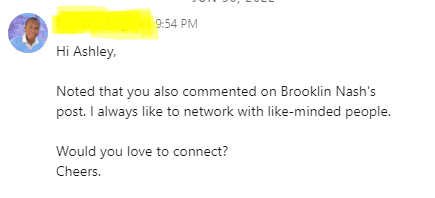Achieving Significant Results with Strategic Phone Follow-ups on LinkedIn

- March 29, 2023
Meet David.
He’s the Sales Director at a pharma company that is launching a new drug. He’s been tasked with finding the right HCPs to test the drug on their patients.
So he tries the good old method of cold calling. He has a list of all the HCPs in his area. However, his cold-calling efforts don’t seem to work.
Why?
He didn’t research his prospects well enough and hence couldn’t have successful conversations. Plus, he didn’t create a robust script to engage the prospects.
So he gives up and launches a Google or Facebook ad campaign which takes a big chunk of the marketing budget he was allocated.
This is a familiar story for most companies regarding cold calling.
However, not every company has the same experience. Cold calling works, and there are a lot of benefits. You just need to do it right.
To get started, here’s a mini case study from our partner at Myphoner, Khalil F. Stultz.
Cold Calling Case study
Khalil F. Stultz worked in an agency where he discovered how big a difference picking up the phone can make in addition to outreach via other channels such as LinkedIn.
The case study took six months, from January 21 to June 2021. He studied multiple companies, including SEO agencies, marketing firms, financial services, and biotech companies.
The campaign targeted ICPs and IPPs (ideal client personas & ideal partner personas) on Linkedin using tailored messaging.
The first phase was to generate interested responses from the prospects and drive them to a booked appointment with the agency’s clients.
On average, the conversion rate from inbox interest to booked appointments was around 15%-20%.
So they decided to add one more step.
They implemented a trained phone call setter to warm call and follow up on interested prospects from LinkedIn. The agency would then screen them with client-specific pre-qualification questions in hopes of getting them booked.
The result was staggering. The conversion of the booked appointment went up to an average of 40% plus.
One of the agency’s SEO clients reported that within the first 21 days of implementing warm phone call follow-up, they had a contracted pending pipeline of $100k in proposals pending, all of which were from interested leads produced from the LinkedIn campaigns.
Supercharge your business's phone outreach today!

A deeper look into why the cold calling campaign worked.
According to Cognism, the average success rate for cold calling is around 2%.
While the rate is lower than other sales techniques, it remains an effective outbound lead generation method.
Conversely, you can still increase the effectiveness by tweaking your sales script, calling at the right time, or even spending more hours researching your prospect to identify unique pain points.
For example, a study by Gong found out that asking prospects how they’ve been increases your success rate by 6.6 times.

That’s just one side of the coin.
One of the best methods to improve cold calling success is taking an omnichannel marketing approach which the agency implemented.
Omnichannel marketing is integrating multiple forms of channels to engage with customers using a unified messaging that cuts across the board.
Here’s an infographic to explain it better.

For example, if you’re a SaaS brand selling an email marketing service, you can create an email outreach campaign to inform prospects about your newest feature.
Once done, you can warm call the same prospects and invite them to a webinar with a CTA to try out the feature.
The all-around approach ensures that your brand has engaged with the customer using all the channels surrounding them.
Research shows that companies that use an omnichannel marketing approach have an 89% success rate compared to those that don’t.

Why brands should incorporate cold calling in their Leads Acquisition
Here are some of the benefits of cold calling:
It’s simple
Nothing is complicated with cold calling. Just pick up a call, dial a phone number, and talk.
Finding the prospects to call is the only “hard thing” to do. Once you’ve got the contacts, you don’t have to dial the numbers all the time; you can use auto-dialing tools like Myphoner.
Furthermore, experienced SDRs don’t have to spend hours creating the perfect sales script. They are ready to go as long as they’ve researched the prospect.
And during the call, they’ll quickly know whether the prospect is interested in listening to their tone. That’s not the same with emails because you must send multiple follow-ups.
Perfect way to build relationships
There’s a common trend I’ve noticed on LinkedIn. Companies are encouraging employees to be brand ambassadors in the name of building relationships.
For example, Mailshake, a sales team engagement, has vocal workers on the platform who talk about sales and prospecting. That’s why the company has an ever-filled client list, according to the CEO, Sujan Patel.
Now, the company is creating relationships with simple LinkedIn posts. Now imagine if they added cold calling to their strategy.
Why?
One-on-one talking will forever be the best way of communication as it allows you to show your human side.
You get to connect with prospects from a personal view. Also, you can express your professionalism, humor, or seriousness. Furthermore, it’s the best method to build rapport and encourage response.
An avenue for learning
Since you’re having a one-on-one conversation with a client, you learn many things about them.
For example, when talking to a prospect, you can better know their problems, other products they’re using, what they think about them, and what they think about your product.
The information is an accurate buyer persona of the prospects you’re targeting. As a result, you can leverage the data to improve your product and strengthen your next cold-calling campaign.
An ideal way to horn your prospecting craft
40% of SDRs say prospecting is the most challenging sales process. But at the same time, 8 out of 10 prospects prefer to talk to SDRs than email.
What does that mean?
More prospects are willing to welcome sale prospecting strategies like cold calling, and they might quickly get interested if the SDRs know how to communicate.
Cold calling throws you into the battleground and teaches you to be comfortable and confident when speaking to prospects. It won’t be easy at first, but the more you keep doing it, the more you gain courage and learn to intrigue prospects.
Cold calling also teaches how to handle rejection in real-time, which is something all SDRs must come across.
How to Make Cold Calls More Effective
The noise is out there.
Every marketer is saying that cold calling is dead.
But here’s the thing.
The same marketers have been saying SEO is dead, social media marketing is dying, and even content marketing has shown some symptoms of dying.

Nothing is dead.
It’s just that the market is changing. People are becoming more aware of their needs, and they know when to get the solution. They are not ready to be forced into buying a product.
So instead of doing the same old things, adapt to the changing environment.
That’s how you can make cold calling work in a stiff business environment. Here are a few unique tips on doing that.
1. Interact with prospects beforehand
Imagine that you receive a connection request on LinkedIn with a well-thought-out message. Something like this:

The person goes ahead to engage with your content. They tag you in their posts and connect with you on other social media platforms.
If you receive a cold call from that person, would you go on with the conversation or hang up?
You’ll probably go with the first option.
Why?
The person has taken the time to build a relationship with you. You’ve interacted multiple times and have developed trust with them.
No one likes to get sold to. But everyone wants to build meaningful and genuine relationships.
You’re pursuing the latter. You want multiple touchpoints with the prospect so they’ll quickly remember you by name or picture when you call.
Furthermore, interacting on social media with prospects gives you an in-depth insight into their pain points. You get personalized data to use as talking points, making your call effective.
2. Don’t over-depend on sales scripts
Sales scripts are great as they help you know what to say when conducting a mass cold-calling campaign.
But again, remember that the market is getting smarter. No one wants to receive generic calls. They’ll quickly know you’re reading from a script. You’ll be lucky if they stay to listen to your pitch.
Personalization is the new way of engaging leads. And by personalization, I don’t mean calling prospects by their first name only.
Sure, it’s good to have something written down like a conversation starter, but reading the sales script word-by-word sounds too robotic.
Double down on research to add more fuel to your personalization. Cold calling is about understanding your prospects' pain points and offering a solution to benefit them.
You lose it when you use it to promote your product. No one cares about your product. They’ve had better. They want to know how you can make their lives easy.
A sales script is too rigid and doesn’t give you the flexibility to navigate the conversation to a positive outcome.
"No matter how many customers you have, each is an individual. The day you start thinking of them as this amorphous ‘collection’ and stop thinking of them as people is the day you start going out of business."
— Dharmesh Shah
3. Aim to create a conversation
In cold calling, never chase money or leads. Instead, pursue meaningful conversations.
Conversations quickly turn into opportunities, then leads. That’s exactly how the sales funnel is designed.
You don’t want to sell to your prospect on that first contact. One of the reasons people hate cold calls is because they appear unsolicited, more so when you want to push your product on someone’s throat whom you’ve never interacted with.
To avoid that feeling, create an environment where you can communicate with the prospect back and forth. You want to suck them into a conversation with you.
Ask relevant and interesting questions and give them room to respond. You also want to make sure the prospect is relaxed. It makes them open with you.
Another thing is to keep the call short unless they seem more interested in your product and are asking more questions.
4. Call at the right time
Knowing the right time to call is crucial.
You don’t want to land on voice mail or get rejected because you called when the prospect had not settled at the office.
Research to find out the best time to call prospects based on industry. Experts advise calling during the later afternoon hours. Most prospects are busy in the morning with meetings or clearing work they’d left the previous day.
In the afternoon, people begin to wind down from the day’s tasks and figure out if they should start another task or call it a day.
Calling at this time fills this gap as it gives them something meaningful to do as they wait to go home. A call between 3:00 PM and 5:00 PM would be perfect.
On the best day of the week to call, Wednesday is the sweet spot, according to studies. This is because prospects are already in full swing for the week and would be open to a conversation that could help their business.
The Takeaway
So let’s quickly recap what we’ve covered in this piece.
Why should you incorporate cold calling as your primary prospecting strategy?
- It’s simple
- Perfect way to build relationships
- An avenue for learning
- An ideal way to horn your prospecting craft
If you want to close more leads with cold calling, here are some tips to help you.
- Interact with Prospects beforehand.
- Don’t over-depend on sales scripts.
- Aim to create a conversation.
- Call at the Right Time.
Hope these tips will help you get positive results in your next cold-calling campaign.
Incorporate cold calling in your business today!


Written by
Jeppe Liisberg
Jeppe Liisberg is a forward-thinking entrepreneur and software developer who has built and contributed to multiple successful startups. With a philosophy centered on creating focused, specialized solutions that excel at solving specific challenges, Jeppe founded Myphoner after identifying a critical gap in the market for effective cold calling software.
"I believe that exceptional software should solve one core problem extraordinarily well rather than attempting to be everything for everyone," says Jeppe. "After years in the trenches as an entrepreneur, I couldn't find a cold calling solution that truly met the needs of small businesses and sales teams—so I built Myphoner to fill that void."
Today, Jeppe remains personally invested in Myphoner's success and customer satisfaction, personally welcoming new users and actively responding to feedback. This hands-on approach ensures that Myphoner continues to evolve based on real user needs while maintaining its commitment to simplicity, effectiveness, and affordability.
Connect with Jeppe on LinkedIn or reach out directly at jeppe@myphoner.com.
Related articles

Industry Related
The Ultimate Guide on Sales and Operations Planning
Learn why sales and operations planning is vital for any sales team & how to effectively implement planning within your organization.
July 28, 2022

Industry Related
A simple way to calculate return on sales
Learn what return on sales (ROS) means, how its beneficial for your sales team & how to effectively calculate your business's ROS.
July 14, 2022

Industry Related
Why Sales Support Matters
Understanding why supporting your sales team is the first step to providing the support to set them up for success.
June 30, 2022